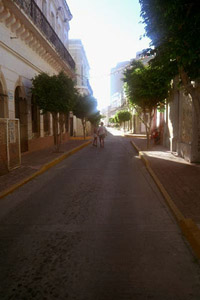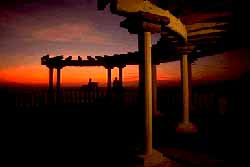Architecture
In
Mazatlan
Various styles of construction are found in Old Mazatlan, but among them the predominant one has neoclassical flourishes with adaptations for a tropical climate.
Mazatlan has 479 buildings designated as national historic landmarks, all locate in the Historic Center of the city. The value of these buildings lies in their age and in the quality of their architectural styles. Some of them were constructed under the supervision of foreigners like the Spaniard don Federico Imaña who designed the buildings along the side of the Plazuela Machado on Calle COnstitucion btween Calles Heriberto Frias and Carnaval, and don Juan Mondini, an Italian builder who had the job of remodeling the Portales de Canobbio.
 |
But there were also Mexicans such as Navidad Librado Tapia, an enginer who gave us the Angela Peralta Theater, and a master named Ramirez who built the old Banco Occidental and various other structures that have survived along Calle Mariano Escobedo. In the 20th century an engineer named Guillermo Freeman incorporated certain art deco forms and Northamerican fuctionalism into Mazatlecan architecture.
This building is one of the most historic in the city. Originally it was just one story and served as a sort of market called Portal de la Lonja. In 1864, during remodeling, the second story was added. Later it was sold to a family who set up an apothecary shop on the premises, and people began to call it Portales de Canobbio after the last name of the owners.
This building occupies the site of one of the first inns in Mazatlan, built in the 1870s as a mansion which functioned for a time under the name Hotel Iturbide, it was there, in Room No. 10, that "the Mexican Nightingale" Angela Peralta died. Days before her death, when her ship landed in Mazatlan, she was received with great jubilation by a large group of Mazatlecos. As a gesture of thanks, she sang from the balcony of her room for the cheering crowd, an event that is reenacted today and is considered very important for the cultural life of the city. By the end of the 19th century, this building had become the Casino de Mazatlan, a popular meeting place for the city's elite. Eventually, around 1965, the first pulmonias to emerge on our streets were built in its courtyard, by then a workshop.
 |
Monument
to the Continuity of Life A symbol of the beginning and end of the humanity's life. The monument is located in the northern zone of Paseo Olas Altas and represents a mixture of races. Some of the areas top restaurants are located in this area. |
The
Paseo del Centenario Pergola This pergola, also called the Angela Peralta Pergola, is a landmark in Mazatlan's history. It was built in 1848 to defend the port. Three English cannons were brought here to defend Mazatlan from foreign invaders during the 19th century. |
 |
 |
Cathedral
Located in the heart of downtown, the cathedral was built during the religious splendor that characterized Sinaloa during the 19th century. The church was named the Basilica Cathedral in 1937 in honor of the Immaculate Conception. The building is marked by its' two slender towers. The interior decor is in the baroque style with exuberant tendencies. |